The Durable Bison
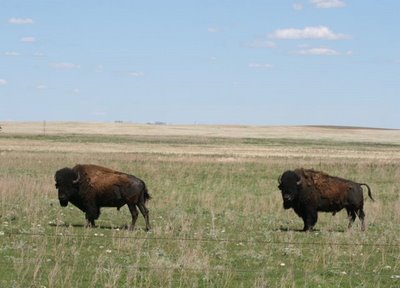
Drive across North Dakota on Highway 200, and you’ll see bison, on billboards, restaurants, and green road signs. My favorite heralds two little towns, named Buffalo and Alice. The words are stacked, reading Buffalo Alice, conjuring up a wooly-haired, gun-slinging, fringe-bedecked cowgirl.
Bison no longer flow like a black river of boulders over buttes and plains. But they are still out there, in scattered herds on private and public land. I spent two mornings with Oren Krapp, who runs 400 head of bison on a 2500 acre piece of virgin prairie outside Pingree, North Dakota. Gray-green grasses, silverbush and buckbrush, buffalo bean and buffalo grass wave in the warm wind as we roll slowly along in a wagon over Oren’s land. This land has never known a plow, and the native prairie plants are diverse and lush.
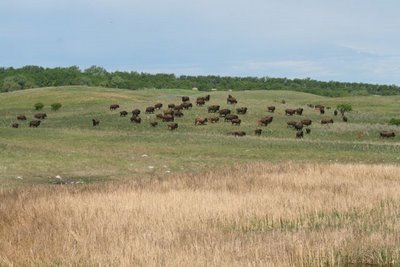
Oren Krapp kept cattle all his life until he got bison. At first he treated them like cattle, rounding them up a couple of times a year to tag and inoculate them. When it came time for slaughter, he’d round them up and truck them to a stockyard to fatten them on corn, trying for a USDA prime rating for the meat. But bison won’t eat more than they need, and they don’t fatten easily. And the handling and capture stressed them so badly that their meat didn’t taste good. So Oren simply stopped doing that. In fact, he stopped doing much at all. He doesn’t round them up anymore, and he doesn’t give them shots or treat them for illnesses, because they never get sick. Cancer, so common in beef cattle, is unknown in bison.
I asked Oren how bison compared to cattle. “In intelligence, the bison is to a beef cow like you are to that rock on the road there.” Bison know what forage to eat and what time of year it’s most nutritious. They’ll switch around so no one plant ever takes over their pasture. In winter, they paw to uncover their food, and in a dry summer they can smell water three miles away, and find it. When the snow piles up and tops Oren’s perimeter fence, his bison go wandering over neighboring land, stopping at the highway. “Nobody minds,” Oren told me. “They don’t hurt anything.” And then they come home, because this oasis of unbroken prairie has everything they need, and they know where they belong.
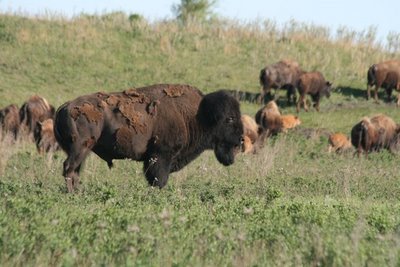 Early on, Oren followed instructions to fence off portions of his range, and permit the bison to graze on only parts of it at one time. "I spent all my time mending fence, until I realized that the bison weren't going for it. Fences don't mean anything to them. Now I let them go wherever they want."
Early on, Oren followed instructions to fence off portions of his range, and permit the bison to graze on only parts of it at one time. "I spent all my time mending fence, until I realized that the bison weren't going for it. Fences don't mean anything to them. Now I let them go wherever they want."Last year, after an April storm dumped four feet of snow, killing 40% of his neighbor’s cattle, Oren went out to check on his bison. One bison cow was down and wouldn’t get up. He thought he’d found his first winter-killed animal. As he pressed closer, she got to her feet, revealing a tiny orange calf, which had been covered by a blanket of the softest wool on its mother’s neck. Mother and baby were fine. A bison cow won’t have her first calf until she’s five or six years old, but she’ll continue calving into her mid-twenties—twice the reproductive lifespan of beef.
We watched a group of cow bison, each one accompanied by a wooly orange calf, dewy-eyed and short-coupled. “A bison will never leave her calf the way a beef will,” he commented. “We’ve got all kinds of coyotes around here, but I don’t worry about them around bison. The coyotes know that if they tried anything with a calf, the herd would be all over them.”
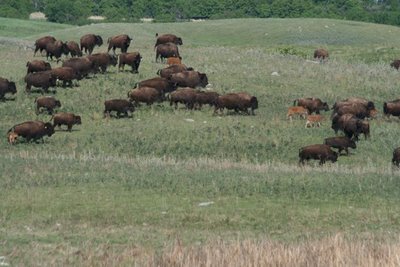
Oren pointed to a distant herd of Herefords, grazing planted fescue on the plowed field just over his fence. “In a hard winter, my neighbor might lose 40% of his cattle, even when he takes them in and feeds them. I leave the bison herd out all winter and don’t lose a one.”
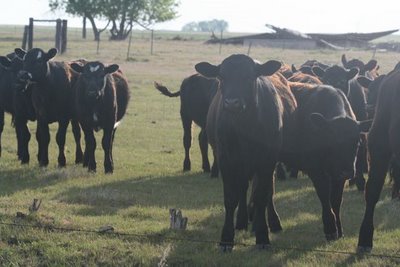
When Oren wishes to cull or harvest an animal, it’s dropped where it stands with a single shot, into the prairie grass where it grew up. No roundup, no trucking, no capture and confinement, no slaughterhouse trauma. There’s an elegance to his operation, a respect for the animal’s natural history and native intelligence, that has been utterly lost in the close-cropped pastures, muddy feedlots, and dark slaughterhouses that define the short lives of beef cattle. We stood on a promontory, facing into the warm wind. On the ancient seabed that stretched below, bison flowed in a black-brown river around a slough, over hill and hummock, disappearing into the distance.
In central North Dakota, a place most of us would call the middle of nowhere, there is a somewhere that retains its ancient vitality. There is an intricate cluster of animals and plants, soil, sky and people, that are as they always were, that are as they should be, that spins in an eddy of time, perfect and endlessly renewed.
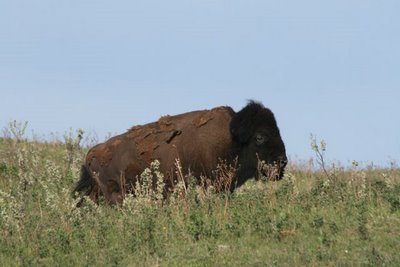
Labels: bison, bison husbandry, North Dakota, unbroken prairie






<< Home